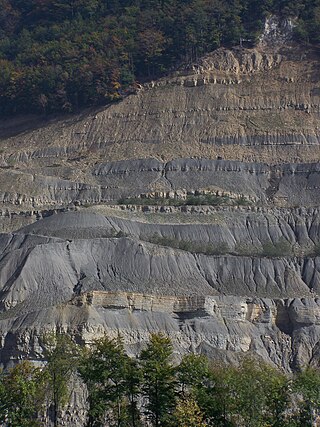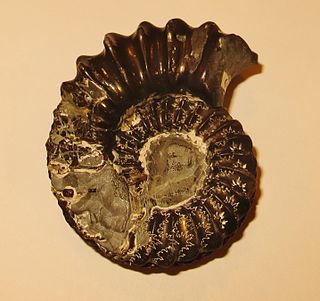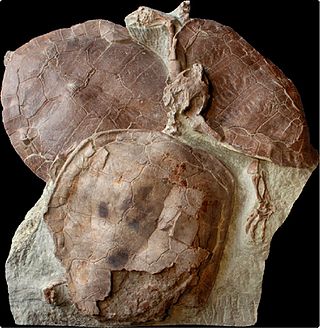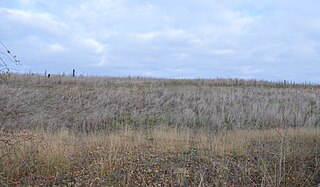In the geologic timescale, the Callovian is an age and stage in the Middle Jurassic, lasting between 165.3 ± 1.1 Ma and 161.5 ± 1.0 Ma. It is the last stage of the Middle Jurassic, following the Bathonian and preceding the Oxfordian.

The Oxfordian is, in the ICS' geologic timescale, the earliest age of the Late Jurassic Epoch, or the lowest stage of the Upper Jurassic Series. It spans the time between 161.5 ± 1.0 Ma and 154.8 ± 0.8 Ma. The Oxfordian is preceded by the Callovian and is followed by the Kimmeridgian.
In the geologic timescale, the Kimmeridgian is an age in the Late Jurassic Epoch and a stage in the Upper Jurassic Series. It spans the time between 154.8 ±0.8 Ma and 149.2 ±0.7 Ma. The Kimmeridgian follows the Oxfordian and precedes the Tithonian.

Anaxyelidae is a family of incense cedar wood wasps in the order Hymenoptera. It contains only one living genus, Syntexis, which has only a single species, native to Western North America. Fossils of the family extend back to the Middle Jurassic, belonging to over a dozen extinct genera, with a particularly high diversity during the Early Cretaceous. Syntexis lay eggs in the sapwood of conifers, preferring recently burnt wood.
Cacibupteryx is a genus of rhamphorhynchid pterosaur from the middle-late Oxfordian-age Upper Jurassic Jagua Formation of Pinar del Río, Cuba.

Hesperornithoides is a genus of troodontid theropod dinosaur that lived in North America during the Late Jurassic period.

Nemestrinidae, or tangle-veined flies is a family of flies in the superfamily Nemestrinoidea, closely related to Acroceridae. The family is small but distributed worldwide, with about 300 species in 34 genera. Larvae are endoparasitoids of either grasshoppers (Trichopsideinae) or scarab beetles (Hirmoneurinae). Some are considered important in the control of grasshopper populations. Adults are often observed on flowers.

Hibolithes is a genus of belemnite that lived from the Middle Jurassic to the Early Cretaceous, and has been found in Antarctica, Greenland, Iran, Europe, South America, and New Zealand. In 2020, this genus was found in the Pedawan Formation in Sarawak, on the island of Borneo (Malaysia).

Varasichthys is an extinct genus of ray-finned fish that lived during the Oxfordian stage of the Late Jurassic epoch. It contains one species, Varasichthys ariasi, fossils of which have been found in the Domeyko Range of Antofagasta Region, northern Chile. It has been placed in the family Varasichthyidae together with the genera Bobbichthys, Domeykos, Luisichthys and Protoclupea.
Protoclupea is an extinct genus of ray-finned fish that lived from the Oxfordian to the early Tithonian stage of the Late Jurassic epoch. It contains one species, Protoclupea chilensis, fossils of which have been found in the Domeyko Range of Antofagasta Region, northern Chile. The genus has been placed in the family Varasichthyidae together with the genera Bobbichthys, Domeykos, Luisichthys and Varasichthys.

Perisphinctoidea, formerly Perisphinctaceae, is a superfamily of Middle Jurassic (Bajocian) to Lower Cretaceous (Barremian) ammonites, commonly with evolute shells with strong ribbing that typically divides about mid flank before crossing the venter.

Hecticoceras is an ammonite genus belonging to the haploceratoid family Oppeliidae, that lived during the Middle and Late Jurassic, from the Callovian. Hecticoceras may be seen as a series of some nine subgenera, beginning with the lower Callovian H. (Hecticoceras) and H. (Hecticoceratoides) and ending with the lower Oxfordian H. (Pseudobrightia) and H. (Eochetoceras). Hecticocerassensu lato and Prohecticoceras from the underlying Bathonian form the oppeliid subfamily, Hecticoceratinae.

Musculus somaliensis is an extinct species of small saltwater mussel, a fossil marine bivalve mollusc in the family Mytilidae, the mussels. The size, shape and sometimes color of these fossils are reminiscent of a pistachio nut.

Somalirhynchia africana is a species of extinct, medium-sized brachiopod, a marine rhynchonellate lampshell in the family Tetrarhynchiidae. It is roughly the size and shape of a 1-inch (25 mm) toy marble, and has about 29 ribs fanning out from the hinge.

Xinjiangchelyidae is an extinct family of turtles known from the Lower Jurassic to the Middle Cretaceous of Asia and western Europe. They have generally been interpreted as either being basal cryptodires or placed outside of crown Testudines.

Warboys Clay Pit is a 12.6-hectare (31-acre) geological Site of Special Scientific Interest west of Warboys in Cambridgeshire. It is a Geological Conservation Review site.

Roproniidae is a family of wasps in the order Hymenoptera, of which only two genera are still extant, the others being fossils.

Archisargidae is an extinct family of brachyceran flies known from the Jurassic and Cretaceous periods. It is part of the extinct superfamily Archisargoidea. Most members of the family are known from the Callovian-Oxfordian Daohugou biota of Inner Mongolia, China, and the equivalently aged Karabastau Formation of Kazakhstan. The family has been found to be paraphyletic with respect to Eremochaetidae in a cladistic analysis.
Lophioneurida is an extinct order of Thysanoptera, dating from the Carboniferous to the Cretaceous. It is likely paraphyletic, with modern thrips having evolved from members of the group.
Liadopsyllidae is an extinct family of hemipteran insects belonging to Psylloidea ranging from the Early Jurassic to Upper Cretaceous. The family was named by Andrey Vasilyevich Martynov in 1926. They are the earliest known members of Psylloidea, with modern members of the group not known until the Paleogene, as such, they have been suggested to be a paraphyletic assemblage ancestral to modern psylloids. The family Malmopsyllidae has been subsumed into this family, but is considered distinct by some authors.














